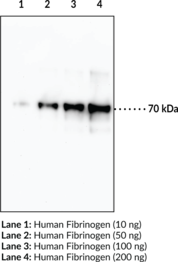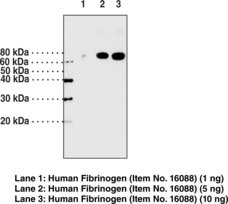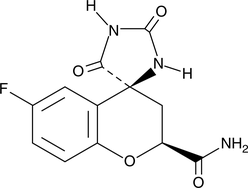Cayman
Showing 20701–20850 of 45550 results
-
Fialuridine (FIAU) is a nucleoside analog with antiviral activity. It inhibits thymidine kinases from herpes simplex virus types 1 and 2 with Ki values of 0.14 and 0.95 µM, respectively, while blocking green monkey Vero cell thymidine kinase less effectively (Ki = 53 µM).{26079} FIAU blocks DNA synthesis in human cytomegalovirus and hepatitis B, as well as herpes simplex.{26078,26080,26081} Notably, while FIAU has few adverse effects in several mammals, it causes mitochondrial toxicity leading to liver damage and death in humans.{26082}
Brand:CaymanSKU:-Fialuridine (FIAU) is a nucleoside analog with antiviral activity. It inhibits thymidine kinases from herpes simplex virus types 1 and 2 with Ki values of 0.14 and 0.95 µM, respectively, while blocking green monkey Vero cell thymidine kinase less effectively (Ki = 53 µM).{26079} FIAU blocks DNA synthesis in human cytomegalovirus and hepatitis B, as well as herpes simplex.{26078,26080,26081} Notably, while FIAU has few adverse effects in several mammals, it causes mitochondrial toxicity leading to liver damage and death in humans.{26082}
Brand:CaymanSKU:-Fialuridine (FIAU) is a nucleoside analog with antiviral activity. It inhibits thymidine kinases from herpes simplex virus types 1 and 2 with Ki values of 0.14 and 0.95 µM, respectively, while blocking green monkey Vero cell thymidine kinase less effectively (Ki = 53 µM).{26079} FIAU blocks DNA synthesis in human cytomegalovirus and hepatitis B, as well as herpes simplex.{26078,26080,26081} Notably, while FIAU has few adverse effects in several mammals, it causes mitochondrial toxicity leading to liver damage and death in humans.{26082}
Brand:CaymanSKU:-Fialuridine (FIAU) is a nucleoside analog with antiviral activity. It inhibits thymidine kinases from herpes simplex virus types 1 and 2 with Ki values of 0.14 and 0.95 µM, respectively, while blocking green monkey Vero cell thymidine kinase less effectively (Ki = 53 µM).{26079} FIAU blocks DNA synthesis in human cytomegalovirus and hepatitis B, as well as herpes simplex.{26078,26080,26081} Notably, while FIAU has few adverse effects in several mammals, it causes mitochondrial toxicity leading to liver damage and death in humans.{26082}
Brand:CaymanSKU:-Immunogen: Human fibrinogen (α chain) • Host: Mouse • Species Reactivity: (+) Human • Applications: WB • MW = 70 kDa
Brand:CaymanSKU:18793- 100 µgAvailable on backorder
Immunogen: Human fibrinogen (α chain) • Host: Mouse • Species Reactivity: (+) Human • Applications: WB • MW = 70 kDa
Brand:CaymanSKU:18793- 100 µgFibrinogen is a hexameric glycoprotein that has roles in coagulation and hemostasis.{53514,53515} It is comprised of two sets of Aα, Bβ, and γ polypeptide chains encoded by FGA, FGB, and FGG, respectively, in humans.{53514} Fibrinogen is synthesized in hepatocytes and secreted into the plasma. Following thrombin-mediated cleavage of N-terminal fibrinopeptides from the Aα and Bβ chains, yielding the α and β chains, respectively, fibrinogen assembles into fibrin protofibrils and then mature fibers, which provide structure and viscoelasticity to blood clots.{53515,53516,53518} Mutations in FGA, FGB, or FGG have been found in patients with afibrinogenemia or hypofibrinogenemia.{53514} Elevated plasma fibrinogen levels are associated with an increased risk of cardiovascular disease.{53517} Immune complexes containing citrullinated fibrinogen have been found in patients with anti-citrullinated protein antibody-positive rheumatoid arthritis.{21643} Cayman’s Fibrinogen (α chain) Monoclonal Antibody can be used for Western blot (WB) applications. The antibody recognizes the α chain of fibrinogen at 70 kDa from human samples.
Brand:CaymanSKU:18793 - 100 µgAvailable on backorder
Immunogen: Peptide from the C-terminal region of human fibrinogen (α chain) • Host: Rabbit • Species Reactivity: (+) Human • Cross Reactivity: (+) Fibrinogen (α chain); (–) fibrinogen (β chain), fibrinogen (γ chain) • Application: WB • MW = 70 kDa
Brand:CaymanSKU:18033- 1 eaAvailable on backorder
Immunogen: Peptide from the C-terminal region of human fibrinogen (α chain) • Host: Rabbit • Species Reactivity: (+) Human • Cross Reactivity: (+) Fibrinogen (α chain); (–) fibrinogen (β chain), fibrinogen (γ chain) • Application: WB • MW = 70 kDa
Brand:CaymanSKU:18033- 1 eaFibrinogen is a hexameric glycoprotein that has roles in coagulation and hemostasis.{53514,53515} It is comprised of two sets of Aα, Bβ, and γ polypeptide chains encoded by FGA, FGB, and FGG, respectively, in humans.{53514} Fibrinogen is synthesized in hepatocytes and secreted into the plasma. Following thrombin-mediated cleavage of N-terminal fibrinopeptides from the Aα and Bβ chains, yielding the α and β chains, respectively, fibrinogen assembles into fibrin protofibrils and then mature fibers, which provide structure and viscoelasticity to blood clots.{53515,53516,53518} Mutations in FGA, FGB, or FGG have been found in patients with afibrinogenemia or hypofibrinogenemia.{53514} Elevated plasma fibrinogen levels are associated with an increased risk of cardiovascular disease.{53517} Immune complexes containing citrullinated fibrinogen have been found in patients with anti-citrullinated protein antibody-positive rheumatoid arthritis.{21643} Cayman’s Fibrinogen (α chain) Polyclonal Antibody can be used for Western blot applications. The antibody recognizes the α chain of fibrinogen at 70 kDa from human samples.
Brand:CaymanSKU:18033 - 1 eaAvailable on backorder
Fidarestat is an aldose reductase inhibitor (IC50 = 0.026 μM using human recombinant enzyme) that also inhibits aldo-keto reductase family 1 member B10 (AKR1B10; IC50 = 33 μM using human recombinant enzyme).{38790} It decreases sorbitol and myo-inositol levels in the sciatic nerve of rats with diabetes induced by streptozotocin (STZ; Item No. 13104) when administered at a dose of 2 mg/kg per day.{38791} Fidarestat (2 mg/kg per day) decreases nerve fiber abnormalities and reverses slowing of motor nerve conduction velocity (MNCV) in an STZ-induced diabetic rat model of peripheral neuropathy. It decreases the pain threshold in STZ-induced diabetic mice that overexpress human aldose reductase when administered at 4 mg/kg per day.{38792} Fidarestat (50 mg/kg per day) decreases metastasis in a KM20 human colorectal cancer mouse xenograft model.{38793}
Brand:CaymanSKU:21756 -Out of stock
Fidarestat is an aldose reductase inhibitor (IC50 = 0.026 μM using human recombinant enzyme) that also inhibits aldo-keto reductase family 1 member B10 (AKR1B10; IC50 = 33 μM using human recombinant enzyme).{38790} It decreases sorbitol and myo-inositol levels in the sciatic nerve of rats with diabetes induced by streptozotocin (STZ; Item No. 13104) when administered at a dose of 2 mg/kg per day.{38791} Fidarestat (2 mg/kg per day) decreases nerve fiber abnormalities and reverses slowing of motor nerve conduction velocity (MNCV) in an STZ-induced diabetic rat model of peripheral neuropathy. It decreases the pain threshold in STZ-induced diabetic mice that overexpress human aldose reductase when administered at 4 mg/kg per day.{38792} Fidarestat (50 mg/kg per day) decreases metastasis in a KM20 human colorectal cancer mouse xenograft model.{38793}
Brand:CaymanSKU:21756 -Out of stock
Fidarestat is an aldose reductase inhibitor (IC50 = 0.026 μM using human recombinant enzyme) that also inhibits aldo-keto reductase family 1 member B10 (AKR1B10; IC50 = 33 μM using human recombinant enzyme).{38790} It decreases sorbitol and myo-inositol levels in the sciatic nerve of rats with diabetes induced by streptozotocin (STZ; Item No. 13104) when administered at a dose of 2 mg/kg per day.{38791} Fidarestat (2 mg/kg per day) decreases nerve fiber abnormalities and reverses slowing of motor nerve conduction velocity (MNCV) in an STZ-induced diabetic rat model of peripheral neuropathy. It decreases the pain threshold in STZ-induced diabetic mice that overexpress human aldose reductase when administered at 4 mg/kg per day.{38792} Fidarestat (50 mg/kg per day) decreases metastasis in a KM20 human colorectal cancer mouse xenograft model.{38793}
Brand:CaymanSKU:21756 -Out of stock
Fidaxomycin is a natural macrocyclic antibiotic that inhibits RNA polymerase with selectivity for Gram-positive bacteria over Gram-negative bacteria (IC50s = 0.4 and 6 μM, respectively).{25092} It has potent antibacterial activity against most Gram-positive bacteria and effectively targets the Gram-positive C. difficile (MIC = 12 ng/ml).{25092} Orally administered fidaxomycin exhibits minimal systemic bioavailability resulting in maximal gastrointestinal tract distribution.{25092} Fidaxomycin is effective in clearing C. difficile infections while sparing Gram-negative bacteria in the gut.{25090,25089}
Brand:CaymanSKU:-Fidaxomycin is a natural macrocyclic antibiotic that inhibits RNA polymerase with selectivity for Gram-positive bacteria over Gram-negative bacteria (IC50s = 0.4 and 6 μM, respectively).{25092} It has potent antibacterial activity against most Gram-positive bacteria and effectively targets the Gram-positive C. difficile (MIC = 12 ng/ml).{25092} Orally administered fidaxomycin exhibits minimal systemic bioavailability resulting in maximal gastrointestinal tract distribution.{25092} Fidaxomycin is effective in clearing C. difficile infections while sparing Gram-negative bacteria in the gut.{25090,25089}
Brand:CaymanSKU:-Fidaxomycin is a natural macrocyclic antibiotic that inhibits RNA polymerase with selectivity for Gram-positive bacteria over Gram-negative bacteria (IC50s = 0.4 and 6 μM, respectively).{25092} It has potent antibacterial activity against most Gram-positive bacteria and effectively targets the Gram-positive C. difficile (MIC = 12 ng/ml).{25092} Orally administered fidaxomycin exhibits minimal systemic bioavailability resulting in maximal gastrointestinal tract distribution.{25092} Fidaxomycin is effective in clearing C. difficile infections while sparing Gram-negative bacteria in the gut.{25090,25089}
Brand:CaymanSKU:-FIIN-2 is an irreversible FGFR inhibitor with IC50 values of 3.09, 4.3, 27, and 45.3 nM for FGFR1, FGFR2, FGFR3, and FGFR4, respectively.{32873} It has been shown to inhibit cell proliferation of transformed Ba/F3 cell lines and demonstrates antiproliferative activity in cells dependent upon the gatekeeper mutants of FGFR1 or FGFR2.{32873} By inhibiting FGFR in a zebrafish developmental model, FIIN-2 caused mild to severe alterations in tail morphogenesis similar to the phenotypes reported following genetic knockdown of FGFR.{32873}
Brand:CaymanSKU:19837 -Available on backorder
FIIN-2 is an irreversible FGFR inhibitor with IC50 values of 3.09, 4.3, 27, and 45.3 nM for FGFR1, FGFR2, FGFR3, and FGFR4, respectively.{32873} It has been shown to inhibit cell proliferation of transformed Ba/F3 cell lines and demonstrates antiproliferative activity in cells dependent upon the gatekeeper mutants of FGFR1 or FGFR2.{32873} By inhibiting FGFR in a zebrafish developmental model, FIIN-2 caused mild to severe alterations in tail morphogenesis similar to the phenotypes reported following genetic knockdown of FGFR.{32873}
Brand:CaymanSKU:19837 -Available on backorder
FIIN-2 is an irreversible FGFR inhibitor with IC50 values of 3.09, 4.3, 27, and 45.3 nM for FGFR1, FGFR2, FGFR3, and FGFR4, respectively.{32873} It has been shown to inhibit cell proliferation of transformed Ba/F3 cell lines and demonstrates antiproliferative activity in cells dependent upon the gatekeeper mutants of FGFR1 or FGFR2.{32873} By inhibiting FGFR in a zebrafish developmental model, FIIN-2 caused mild to severe alterations in tail morphogenesis similar to the phenotypes reported following genetic knockdown of FGFR.{32873}
Brand:CaymanSKU:19837 -Available on backorder
FIIN-2 is an irreversible FGFR inhibitor with IC50 values of 3.09, 4.3, 27, and 45.3 nM for FGFR1, FGFR2, FGFR3, and FGFR4, respectively.{32873} It has been shown to inhibit cell proliferation of transformed Ba/F3 cell lines and demonstrates antiproliferative activity in cells dependent upon the gatekeeper mutants of FGFR1 or FGFR2.{32873} By inhibiting FGFR in a zebrafish developmental model, FIIN-2 caused mild to severe alterations in tail morphogenesis similar to the phenotypes reported following genetic knockdown of FGFR.{32873}
Brand:CaymanSKU:19837 -Available on backorder
FIIN-3 is an inhibitor of FGF receptors (FGFRs; IC50s = 13, 21, 31, and 35 nM for recombinant FGFR1-4, respectively).{32873} It is selective for FGFRs over a panel of 456 kinases at a concentration of 1 μM, however, it does inhibit EGFR (IC50 = 204 nM). FIIN-3 inhibits growth of Ba/F3 cells that are dependent on the kinase activity of wild-type FGFR1-4 as well as gatekeeper mutant FGFR2 and FGFR3 (EC50s = TEL/V564M-dependent Ba/F3 cells. FIIN-3 also inhibits growth in a panel of cancer cell lines (EC50s = 1.4-499 nM).
Brand:CaymanSKU:20709 -Available on backorder
FIIN-3 is an inhibitor of FGF receptors (FGFRs; IC50s = 13, 21, 31, and 35 nM for recombinant FGFR1-4, respectively).{32873} It is selective for FGFRs over a panel of 456 kinases at a concentration of 1 μM, however, it does inhibit EGFR (IC50 = 204 nM). FIIN-3 inhibits growth of Ba/F3 cells that are dependent on the kinase activity of wild-type FGFR1-4 as well as gatekeeper mutant FGFR2 and FGFR3 (EC50s = TEL/V564M-dependent Ba/F3 cells. FIIN-3 also inhibits growth in a panel of cancer cell lines (EC50s = 1.4-499 nM).
Brand:CaymanSKU:20709 -Available on backorder
FIIN-3 is an inhibitor of FGF receptors (FGFRs; IC50s = 13, 21, 31, and 35 nM for recombinant FGFR1-4, respectively).{32873} It is selective for FGFRs over a panel of 456 kinases at a concentration of 1 μM, however, it does inhibit EGFR (IC50 = 204 nM). FIIN-3 inhibits growth of Ba/F3 cells that are dependent on the kinase activity of wild-type FGFR1-4 as well as gatekeeper mutant FGFR2 and FGFR3 (EC50s = TEL/V564M-dependent Ba/F3 cells. FIIN-3 also inhibits growth in a panel of cancer cell lines (EC50s = 1.4-499 nM).
Brand:CaymanSKU:20709 -Available on backorder
FIIN-3 is an inhibitor of FGF receptors (FGFRs; IC50s = 13, 21, 31, and 35 nM for recombinant FGFR1-4, respectively).{32873} It is selective for FGFRs over a panel of 456 kinases at a concentration of 1 μM, however, it does inhibit EGFR (IC50 = 204 nM). FIIN-3 inhibits growth of Ba/F3 cells that are dependent on the kinase activity of wild-type FGFR1-4 as well as gatekeeper mutant FGFR2 and FGFR3 (EC50s = TEL/V564M-dependent Ba/F3 cells. FIIN-3 also inhibits growth in a panel of cancer cell lines (EC50s = 1.4-499 nM).
Brand:CaymanSKU:20709 -Available on backorder
Filgotinib is a JAK1 inhibitor (IC50 = 10 nM).{30750} It is selective for JAK1 over JAK3 (IC50 = 810 nM) but also inhibits JAK2 and tyrosine kinase 2 (Tyk2; IC50s = 28 and 116 nM, respectively), as well as Abl, FLT1, -3, and -4, FMS, Mer, and TBK1 activity by greater than 35% in a panel of 177 tyrosine kinases at 1 µM. Filgotinib inhibits IL-6-induced phosphorylation of STAT1 in CD4+ T cells with an IC50 value of 629 nM in isolated human whole blood. It reduces hind paw macrophage and T cell infiltration and bone erosion in a rat model of collagen-induced arthritis when administered at doses ranging from 0.1 to 30 mg/kg per day for 15 days.
Brand:CaymanSKU:-Available on backorder
Filgotinib is a JAK1 inhibitor (IC50 = 10 nM).{30750} It is selective for JAK1 over JAK3 (IC50 = 810 nM) but also inhibits JAK2 and tyrosine kinase 2 (Tyk2; IC50s = 28 and 116 nM, respectively), as well as Abl, FLT1, -3, and -4, FMS, Mer, and TBK1 activity by greater than 35% in a panel of 177 tyrosine kinases at 1 µM. Filgotinib inhibits IL-6-induced phosphorylation of STAT1 in CD4+ T cells with an IC50 value of 629 nM in isolated human whole blood. It reduces hind paw macrophage and T cell infiltration and bone erosion in a rat model of collagen-induced arthritis when administered at doses ranging from 0.1 to 30 mg/kg per day for 15 days.
Brand:CaymanSKU:-Available on backorder
Filgotinib is a JAK1 inhibitor (IC50 = 10 nM).{30750} It is selective for JAK1 over JAK3 (IC50 = 810 nM) but also inhibits JAK2 and tyrosine kinase 2 (Tyk2; IC50s = 28 and 116 nM, respectively), as well as Abl, FLT1, -3, and -4, FMS, Mer, and TBK1 activity by greater than 35% in a panel of 177 tyrosine kinases at 1 µM. Filgotinib inhibits IL-6-induced phosphorylation of STAT1 in CD4+ T cells with an IC50 value of 629 nM in isolated human whole blood. It reduces hind paw macrophage and T cell infiltration and bone erosion in a rat model of collagen-induced arthritis when administered at doses ranging from 0.1 to 30 mg/kg per day for 15 days.
Brand:CaymanSKU:-Available on backorder
Filgotinib is a JAK1 inhibitor (IC50 = 10 nM).{30750} It is selective for JAK1 over JAK3 (IC50 = 810 nM) but also inhibits JAK2 and tyrosine kinase 2 (Tyk2; IC50s = 28 and 116 nM, respectively), as well as Abl, FLT1, -3, and -4, FMS, Mer, and TBK1 activity by greater than 35% in a panel of 177 tyrosine kinases at 1 µM. Filgotinib inhibits IL-6-induced phosphorylation of STAT1 in CD4+ T cells with an IC50 value of 629 nM in isolated human whole blood. It reduces hind paw macrophage and T cell infiltration and bone erosion in a rat model of collagen-induced arthritis when administered at doses ranging from 0.1 to 30 mg/kg per day for 15 days.
Brand:CaymanSKU:-Available on backorder
Filgotinib-d4 is intended for use as an internal standard for the quantification of filgotinib (Item No. 17669) by GC- or LC-MS. Filgotinib is a JAK1 inhibitor (IC50 = 10 nM).{30750} It is selective for JAK1 over JAK3 (IC50 = 810 nM) but also inhibits JAK2 and tyrosine kinase 2 (Tyk2; IC50s = 28 and 116 nM, respectively), as well as Abl, FLT1, -3 and -4, FMS, Mer, and TBK1 activity by greater than 35% in a panel of 177 tyrosine kinases at 1 µM. Filgotinib inhibits IL-6-induced phosphorylation of STAT1 in CD4+ T cells with an IC50 value of 629 nM in isolated human whole blood. It reduces hind paw macrophage and T cell infiltration and bone erosion in a rat model of collagen-induced arthritis when administered at doses ranging from 0.1 to 30 mg/kg per day for 15 days.
Brand:CaymanSKU:28875 - 1 mgAvailable on backorder
Filgotinib-d4 is intended for use as an internal standard for the quantification of filgotinib (Item No. 17669) by GC- or LC-MS. Filgotinib is a JAK1 inhibitor (IC50 = 10 nM).{30750} It is selective for JAK1 over JAK3 (IC50 = 810 nM) but also inhibits JAK2 and tyrosine kinase 2 (Tyk2; IC50s = 28 and 116 nM, respectively), as well as Abl, FLT1, -3 and -4, FMS, Mer, and TBK1 activity by greater than 35% in a panel of 177 tyrosine kinases at 1 µM. Filgotinib inhibits IL-6-induced phosphorylation of STAT1 in CD4+ T cells with an IC50 value of 629 nM in isolated human whole blood. It reduces hind paw macrophage and T cell infiltration and bone erosion in a rat model of collagen-induced arthritis when administered at doses ranging from 0.1 to 30 mg/kg per day for 15 days.
Brand:CaymanSKU:28875 - 5 mgAvailable on backorder
Filipin complex is a neutral polyene originally isolated from S. filipinensis with antifungal activity.{42119} It inhibits cell growth as well as mitochondrial terminal electron transport in S. cerevisiae when used at a concentration of 135 µg/ml. Filipin complex binds to various sterols, particularly 24α-methyl cholesterol (Item no. 17344), 24α-ethyl cholesterol (Item no. 11756), and cholesterol, in aqueous solutions and in fungal cell membranes when used at a concentration of 50 µg/ml, inducing membrane pit formation and leakage of cell contents.{42120,9103,42106} It is a fluorescent compound that has been used to label sterols within biological structures for imaging.{9103,8625,42104,42105} Filipin complex displays excitation/emission maxima of 338/480 nm, respectively.
Brand:CaymanSKU:25073 - 25 mgAvailable on backorder
Filipin complex is a neutral polyene originally isolated from S. filipinensis with antifungal activity.{42119} It inhibits cell growth as well as mitochondrial terminal electron transport in S. cerevisiae when used at a concentration of 135 µg/ml. Filipin complex binds to various sterols, particularly 24α-methyl cholesterol (Item no. 17344), 24α-ethyl cholesterol (Item no. 11756), and cholesterol, in aqueous solutions and in fungal cell membranes when used at a concentration of 50 µg/ml, inducing membrane pit formation and leakage of cell contents.{42120,9103,42106} It is a fluorescent compound that has been used to label sterols within biological structures for imaging.{9103,8625,42104,42105} Filipin complex displays excitation/emission maxima of 338/480 nm, respectively.
Brand:CaymanSKU:25073 - 5 mgAvailable on backorder
Filipin II is a polyene and an active component of the polyene antibiotic filipin complex (Item No. 25073).{39829} It has broad-spectrum antifungal activity, reducing growth of various fungi, including B. dermatitidis, C. neoformans, and H. capsulatum (MICs = 1-10 μg/ml). Filipin II inhibits ADP-stimulated respiration in rat liver mitochondria when used at a concentration of 3.5 mg/ml.{39830} It also induces hemolysis of liposomes in a cholesterol-independent manner (IC50 = 0.5 μg/ml).{39831}
Brand:CaymanSKU:25521 - 2.5 mgAvailable on backorder
Filipin II is a polyene and an active component of the polyene antibiotic filipin complex (Item No. 25073).{39829} It has broad-spectrum antifungal activity, reducing growth of various fungi, including B. dermatitidis, C. neoformans, and H. capsulatum (MICs = 1-10 μg/ml). Filipin II inhibits ADP-stimulated respiration in rat liver mitochondria when used at a concentration of 3.5 mg/ml.{39830} It also induces hemolysis of liposomes in a cholesterol-independent manner (IC50 = 0.5 μg/ml).{39831}
Brand:CaymanSKU:25521 - 500 µgAvailable on backorder
Cholesterol is both an important structural component of cell membranes and an early intermediate in hormone and bile acid biosynthesis. The localization and measurement of cholesterol in cells is therefore of great interest. Filipin is the collective name given to four isomeric polyene macrolides isolated from cultures of S. filipinensis; Filipin III is the predominant isomer and the one used in most studies. Filipin binds to cholesterol in membranes, forming ultrastructural aggregates and complexes which can be visualized by freeze-fracture electron microscopy.{8625,9103} The binding of cholesterol also decreases the intrinsic fluorescence of Filipin, and this property has also been used to detect cholesterol in membrane fractions.{9104}
Brand:CaymanSKU:70440 - 1 mgAvailable on backorder
Cholesterol is both an important structural component of cell membranes and an early intermediate in hormone and bile acid biosynthesis. The localization and measurement of cholesterol in cells is therefore of great interest. Filipin is the collective name given to four isomeric polyene macrolides isolated from cultures of S. filipinensis; Filipin III is the predominant isomer and the one used in most studies. Filipin binds to cholesterol in membranes, forming ultrastructural aggregates and complexes which can be visualized by freeze-fracture electron microscopy.{8625,9103} The binding of cholesterol also decreases the intrinsic fluorescence of Filipin, and this property has also been used to detect cholesterol in membrane fractions.{9104}
Brand:CaymanSKU:70440 - 5 mgAvailable on backorder
Cholesterol is both an important structural component of cell membranes and an early intermediate in hormone and bile acid biosynthesis. The localization and measurement of cholesterol in cells is therefore of great interest. Filipin is the collective name given to four isomeric polyene macrolides isolated from cultures of S. filipinensis; Filipin III is the predominant isomer and the one used in most studies. Filipin binds to cholesterol in membranes, forming ultrastructural aggregates and complexes which can be visualized by freeze-fracture electron microscopy.{8625,9103} The binding of cholesterol also decreases the intrinsic fluorescence of Filipin, and this property has also been used to detect cholesterol in membrane fractions.{9104}
Brand:CaymanSKU:70440 - 500 µgAvailable on backorder
Filorexant is a dual antagonist of orexin 1 receptor (OX1R) and OX2R (Kis = 2.5 and 0.31 nM, respectively, for the recombinant human receptors).{48849} It selectively inhibits OX1R and OX2R over a panel of more than 170 receptors and enzymes. Filorexant inhibits orexin A-induced calcium mobilization in CHO cells expressing recombinant human OX1R or OX2R (Kb = 11 nM for both). It decreases locomotor activity in rats during the dark cycle when administered at a dose of 10 mg/kg. Filorexant (0.5 mg/kg) reduces the time spent awake and decreases the latency to slow-wave sleep stage 1 (SWS1) and SWS2, but not rapid eye movement (REM) sleep, in dogs. It increases the duration of SWS2, but not SWS1 or REM sleep, in the same model.
Brand:CaymanSKU:29490 - 10 mgAvailable on backorder
Filorexant is a dual antagonist of orexin 1 receptor (OX1R) and OX2R (Kis = 2.5 and 0.31 nM, respectively, for the recombinant human receptors).{48849} It selectively inhibits OX1R and OX2R over a panel of more than 170 receptors and enzymes. Filorexant inhibits orexin A-induced calcium mobilization in CHO cells expressing recombinant human OX1R or OX2R (Kb = 11 nM for both). It decreases locomotor activity in rats during the dark cycle when administered at a dose of 10 mg/kg. Filorexant (0.5 mg/kg) reduces the time spent awake and decreases the latency to slow-wave sleep stage 1 (SWS1) and SWS2, but not rapid eye movement (REM) sleep, in dogs. It increases the duration of SWS2, but not SWS1 or REM sleep, in the same model.
Brand:CaymanSKU:29490 - 25 mgAvailable on backorder
Filorexant is a dual antagonist of orexin 1 receptor (OX1R) and OX2R (Kis = 2.5 and 0.31 nM, respectively, for the recombinant human receptors).{48849} It selectively inhibits OX1R and OX2R over a panel of more than 170 receptors and enzymes. Filorexant inhibits orexin A-induced calcium mobilization in CHO cells expressing recombinant human OX1R or OX2R (Kb = 11 nM for both). It decreases locomotor activity in rats during the dark cycle when administered at a dose of 10 mg/kg. Filorexant (0.5 mg/kg) reduces the time spent awake and decreases the latency to slow-wave sleep stage 1 (SWS1) and SWS2, but not rapid eye movement (REM) sleep, in dogs. It increases the duration of SWS2, but not SWS1 or REM sleep, in the same model.
Brand:CaymanSKU:29490 - 5 mgAvailable on backorder
Filorexant is a dual antagonist of orexin 1 receptor (OX1R) and OX2R (Kis = 2.5 and 0.31 nM, respectively, for the recombinant human receptors).{48849} It selectively inhibits OX1R and OX2R over a panel of more than 170 receptors and enzymes. Filorexant inhibits orexin A-induced calcium mobilization in CHO cells expressing recombinant human OX1R or OX2R (Kb = 11 nM for both). It decreases locomotor activity in rats during the dark cycle when administered at a dose of 10 mg/kg. Filorexant (0.5 mg/kg) reduces the time spent awake and decreases the latency to slow-wave sleep stage 1 (SWS1) and SWS2, but not rapid eye movement (REM) sleep, in dogs. It increases the duration of SWS2, but not SWS1 or REM sleep, in the same model.
Brand:CaymanSKU:29490 - 50 mgAvailable on backorder
FIN56 is an inducer of ferroptosis and a derivative of CIL56 (Item No. 19287).{39186} It selectively induces ferroptosis in BJ cells overexpressing oncogenic HRASG12V via acetyl-CoA carboxylase-dependent reduction in expression of GPX4 protein. This effect is reversed by the ferroptosis inhibitors deferoxamine (Item No. 14595) and α-tocopherol as well as overexpression of the fusion protein GFP-GPX4. FIN56 also binds to and activates squalene synthase in a GPX4 degradation-independent manner.
Brand:CaymanSKU:25180 - 10 mgAvailable on backorder
FIN56 is an inducer of ferroptosis and a derivative of CIL56 (Item No. 19287).{39186} It selectively induces ferroptosis in BJ cells overexpressing oncogenic HRASG12V via acetyl-CoA carboxylase-dependent reduction in expression of GPX4 protein. This effect is reversed by the ferroptosis inhibitors deferoxamine (Item No. 14595) and α-tocopherol as well as overexpression of the fusion protein GFP-GPX4. FIN56 also binds to and activates squalene synthase in a GPX4 degradation-independent manner.
Brand:CaymanSKU:25180 - 25 mgAvailable on backorder
FIN56 is an inducer of ferroptosis and a derivative of CIL56 (Item No. 19287).{39186} It selectively induces ferroptosis in BJ cells overexpressing oncogenic HRASG12V via acetyl-CoA carboxylase-dependent reduction in expression of GPX4 protein. This effect is reversed by the ferroptosis inhibitors deferoxamine (Item No. 14595) and α-tocopherol as well as overexpression of the fusion protein GFP-GPX4. FIN56 also binds to and activates squalene synthase in a GPX4 degradation-independent manner.
Brand:CaymanSKU:25180 - 5 mgAvailable on backorder
FIN56 is an inducer of ferroptosis and a derivative of CIL56 (Item No. 19287).{39186} It selectively induces ferroptosis in BJ cells overexpressing oncogenic HRASG12V via acetyl-CoA carboxylase-dependent reduction in expression of GPX4 protein. This effect is reversed by the ferroptosis inhibitors deferoxamine (Item No. 14595) and α-tocopherol as well as overexpression of the fusion protein GFP-GPX4. FIN56 also binds to and activates squalene synthase in a GPX4 degradation-independent manner.
Brand:CaymanSKU:25180 - 50 mgAvailable on backorder
Brand:CaymanSKU:22410 -Out of stock
Brand:CaymanSKU:22410 -Out of stock
Brand:CaymanSKU:22410 -Out of stock
Finasteride is a 4-azasteroid competitive inhibitor of 5α-reductase type II (IC50 = 4.2 nM) and a derivative of testosterone.{23862} It is 100-fold selective for 5α-reductase type II over type I. Finasteride (10 µM) does not affect the growth of androgen-refractory PC3 prostate cancer cells but increases the protein levels of Nrf2 and heme oxygenase-1 (HO-1).{23866} It decreases prostatic diameter and volume, as well as dihydrotestosterone, but not testosterone, serum levels in dogs with spontaneous benign prostatic hypertrophy when administered at doses of 0.1 and 0.5 mg/kg.{48477} Finasteride reduces testosterone-induced type I procollagen and TGF-β1 protein levels in cultured human scalp dermal fibroblasts in a model of androgenic alopecia when applied at a concentration of 0.1 μM.{23865} Formulations containing finasteride have been used in the treatment of benign prostatic hyperplasia and androgenic alopecia in men.
Brand:CaymanSKU:-Finasteride is a 4-azasteroid competitive inhibitor of 5α-reductase type II (IC50 = 4.2 nM) and a derivative of testosterone.{23862} It is 100-fold selective for 5α-reductase type II over type I. Finasteride (10 µM) does not affect the growth of androgen-refractory PC3 prostate cancer cells but increases the protein levels of Nrf2 and heme oxygenase-1 (HO-1).{23866} It decreases prostatic diameter and volume, as well as dihydrotestosterone, but not testosterone, serum levels in dogs with spontaneous benign prostatic hypertrophy when administered at doses of 0.1 and 0.5 mg/kg.{48477} Finasteride reduces testosterone-induced type I procollagen and TGF-β1 protein levels in cultured human scalp dermal fibroblasts in a model of androgenic alopecia when applied at a concentration of 0.1 μM.{23865} Formulations containing finasteride have been used in the treatment of benign prostatic hyperplasia and androgenic alopecia in men.
Brand:CaymanSKU:-Finasteride is a 4-azasteroid competitive inhibitor of 5α-reductase type II (IC50 = 4.2 nM) and a derivative of testosterone.{23862} It is 100-fold selective for 5α-reductase type II over type I. Finasteride (10 µM) does not affect the growth of androgen-refractory PC3 prostate cancer cells but increases the protein levels of Nrf2 and heme oxygenase-1 (HO-1).{23866} It decreases prostatic diameter and volume, as well as dihydrotestosterone, but not testosterone, serum levels in dogs with spontaneous benign prostatic hypertrophy when administered at doses of 0.1 and 0.5 mg/kg.{48477} Finasteride reduces testosterone-induced type I procollagen and TGF-β1 protein levels in cultured human scalp dermal fibroblasts in a model of androgenic alopecia when applied at a concentration of 0.1 μM.{23865} Formulations containing finasteride have been used in the treatment of benign prostatic hyperplasia and androgenic alopecia in men.
Brand:CaymanSKU:-Finasteride-d9 is intended for use as an internal standard for the quantification of finasteride (Item No. 14938) by GC- or LC-MS. Finasteride is a 4-azasteroid competitive inhibitor of 5α-reductase type II (IC50 = 4.2 nM) and a derivative of testosterone.{23862} It is 100-fold selective for 5α-reductase type II over type I. Finasteride (10 µM) does not affect the growth of androgen-refractory PC3 prostate cancer cells but increases the protein levels of Nrf2 and heme oxygenase-1 (HO-1).{23866} It decreases prostatic diameter and volume, as well as dihydrotestosterone, but not testosterone, serum levels in dogs with spontaneous benign prostatic hypertrophy when administered at doses of 0.1 and 0.5 mg/kg.{48477} Finasteride reduces testosterone-induced type I procollagen and TGF-β1 protein levels in cultured human scalp dermal fibroblasts in a model of androgenic alopecia when applied at a concentration of 0.1 μM.{23865} Formulations containing finasteride have been used in the treatment of benign prostatic hyperplasia and androgenic alopecia in men.
Brand:CaymanSKU:28482 - 1 mgAvailable on backorder
Finasteride-d9 is intended for use as an internal standard for the quantification of finasteride (Item No. 14938) by GC- or LC-MS. Finasteride is a 4-azasteroid competitive inhibitor of 5α-reductase type II (IC50 = 4.2 nM) and a derivative of testosterone.{23862} It is 100-fold selective for 5α-reductase type II over type I. Finasteride (10 µM) does not affect the growth of androgen-refractory PC3 prostate cancer cells but increases the protein levels of Nrf2 and heme oxygenase-1 (HO-1).{23866} It decreases prostatic diameter and volume, as well as dihydrotestosterone, but not testosterone, serum levels in dogs with spontaneous benign prostatic hypertrophy when administered at doses of 0.1 and 0.5 mg/kg.{48477} Finasteride reduces testosterone-induced type I procollagen and TGF-β1 protein levels in cultured human scalp dermal fibroblasts in a model of androgenic alopecia when applied at a concentration of 0.1 μM.{23865} Formulations containing finasteride have been used in the treatment of benign prostatic hyperplasia and androgenic alopecia in men.
Brand:CaymanSKU:28482 - 500 µgAvailable on backorder
Fingolimod is a derivative of ISP-1 (myriocin), a fungal metabolite of the Chinese herb I. sinclarii as well as a structural analog of sphingosine. It is a novel immune modulator that prolongs allograft transplant survival in numerous models by inhibiting lymphocyte emigration from lymphoid organs.{11265} Fingolimod is phosphorylated by sphingosine kinase, which then acts as a potent agonist at four of the sphingosine-1-phosphate (S1P) receptors (S1P1, S1P3, S1P4, and S1P5).{11284} Down-regulation of S1P1 receptors on T and B lymphocytes by fingolimod results in defective egress of these cells from spleen, lymph nodes, and Peyer’s patch.{11738} Fingolimod also enhances the activity of the sphingosine transporter Abcb1 and the leukotriene C4 transporter Abcc1 and inhibits cytosolic phospholipase A2 (PLA2) activity.{11283,14604}
Brand:CaymanSKU:11975 - 10 mgAvailable on backorder
Fingolimod is a derivative of ISP-1 (myriocin), a fungal metabolite of the Chinese herb I. sinclarii as well as a structural analog of sphingosine. It is a novel immune modulator that prolongs allograft transplant survival in numerous models by inhibiting lymphocyte emigration from lymphoid organs.{11265} Fingolimod is phosphorylated by sphingosine kinase, which then acts as a potent agonist at four of the sphingosine-1-phosphate (S1P) receptors (S1P1, S1P3, S1P4, and S1P5).{11284} Down-regulation of S1P1 receptors on T and B lymphocytes by fingolimod results in defective egress of these cells from spleen, lymph nodes, and Peyer’s patch.{11738} Fingolimod also enhances the activity of the sphingosine transporter Abcb1 and the leukotriene C4 transporter Abcc1 and inhibits cytosolic phospholipase A2 (PLA2) activity.{11283,14604}
Brand:CaymanSKU:11975 - 25 mgAvailable on backorder
Fingolimod is a derivative of ISP-1 (myriocin), a fungal metabolite of the Chinese herb I. sinclarii as well as a structural analog of sphingosine. It is a novel immune modulator that prolongs allograft transplant survival in numerous models by inhibiting lymphocyte emigration from lymphoid organs.{11265} Fingolimod is phosphorylated by sphingosine kinase, which then acts as a potent agonist at four of the sphingosine-1-phosphate (S1P) receptors (S1P1, S1P3, S1P4, and S1P5).{11284} Down-regulation of S1P1 receptors on T and B lymphocytes by fingolimod results in defective egress of these cells from spleen, lymph nodes, and Peyer’s patch.{11738} Fingolimod also enhances the activity of the sphingosine transporter Abcb1 and the leukotriene C4 transporter Abcc1 and inhibits cytosolic phospholipase A2 (PLA2) activity.{11283,14604}
Brand:CaymanSKU:11975 - 5 mgAvailable on backorder
Fingolimod is a derivative of ISP-1 (myriocin), a fungal metabolite of the Chinese herb I. sinclarii as well as a structural analog of sphingosine. It is a novel immune modulator that prolongs allograft transplant survival in numerous models by inhibiting lymphocyte emigration from lymphoid organs.{11265} Fingolimod is phosphorylated by sphingosine kinase, which then acts as a potent agonist at four of the sphingosine-1-phosphate (S1P) receptors (S1P1, S1P3, S1P4, and S1P5).{11284} Down-regulation of S1P1 receptors on T and B lymphocytes by fingolimod results in defective egress of these cells from spleen, lymph nodes, and Peyer’s patch.{11738} Fingolimod also enhances the activity of the sphingosine transporter Abcb1 and the leukotriene C4 transporter Abcc1 and inhibits cytosolic phospholipase A2 (PLA2) activity.{11283,14604}
Brand:CaymanSKU:11975 - 50 mgAvailable on backorder
Fingolimod is a derivative of ISP-1 (myriocin), a fungal metabolite of the Chinese herb Iscaria sinclarii as well as a structural analog of sphingosine. It is a novel immune modulator that prolongs allograft transplant survival in numerous models by inhibiting lymphocyte emigration from lymphoid organs.{11265} Fingolimod is phosphorylated by sphingosine kinase, which then acts as a potent agonist at four of the sphingosine-1-phosphate (S1P) receptors (S1P1, S1P3, S1P4, and S1P5).{11284} Down-regulation of S1P1 receptors on T and B lymphocytes by fingolimod results in defective egress of these cells from spleen, lymph nodes, and Peyer’s patch.{11738} Fingolimod also enhances the activity of the sphingosine transporter Abcb1 and the leukotriene C4 transporter Abcc1 and inhibits cytosolic phospholipase A2 activity.{11283,14604}
Brand:CaymanSKU:10006292 - 1 gAvailable on backorder
Fingolimod is a derivative of ISP-1 (myriocin), a fungal metabolite of the Chinese herb Iscaria sinclarii as well as a structural analog of sphingosine. It is a novel immune modulator that prolongs allograft transplant survival in numerous models by inhibiting lymphocyte emigration from lymphoid organs.{11265} Fingolimod is phosphorylated by sphingosine kinase, which then acts as a potent agonist at four of the sphingosine-1-phosphate (S1P) receptors (S1P1, S1P3, S1P4, and S1P5).{11284} Down-regulation of S1P1 receptors on T and B lymphocytes by fingolimod results in defective egress of these cells from spleen, lymph nodes, and Peyer’s patch.{11738} Fingolimod also enhances the activity of the sphingosine transporter Abcb1 and the leukotriene C4 transporter Abcc1 and inhibits cytosolic phospholipase A2 activity.{11283,14604}
Brand:CaymanSKU:10006292 - 100 mgAvailable on backorder
Fingolimod is a derivative of ISP-1 (myriocin), a fungal metabolite of the Chinese herb Iscaria sinclarii as well as a structural analog of sphingosine. It is a novel immune modulator that prolongs allograft transplant survival in numerous models by inhibiting lymphocyte emigration from lymphoid organs.{11265} Fingolimod is phosphorylated by sphingosine kinase, which then acts as a potent agonist at four of the sphingosine-1-phosphate (S1P) receptors (S1P1, S1P3, S1P4, and S1P5).{11284} Down-regulation of S1P1 receptors on T and B lymphocytes by fingolimod results in defective egress of these cells from spleen, lymph nodes, and Peyer’s patch.{11738} Fingolimod also enhances the activity of the sphingosine transporter Abcb1 and the leukotriene C4 transporter Abcc1 and inhibits cytosolic phospholipase A2 activity.{11283,14604}
Brand:CaymanSKU:10006292 - 250 mgAvailable on backorder
Fingolimod is a derivative of ISP-1 (myriocin), a fungal metabolite of the Chinese herb Iscaria sinclarii as well as a structural analog of sphingosine. It is a novel immune modulator that prolongs allograft transplant survival in numerous models by inhibiting lymphocyte emigration from lymphoid organs.{11265} Fingolimod is phosphorylated by sphingosine kinase, which then acts as a potent agonist at four of the sphingosine-1-phosphate (S1P) receptors (S1P1, S1P3, S1P4, and S1P5).{11284} Down-regulation of S1P1 receptors on T and B lymphocytes by fingolimod results in defective egress of these cells from spleen, lymph nodes, and Peyer’s patch.{11738} Fingolimod also enhances the activity of the sphingosine transporter Abcb1 and the leukotriene C4 transporter Abcc1 and inhibits cytosolic phospholipase A2 activity.{11283,14604}
Brand:CaymanSKU:10006292 - 50 mgAvailable on backorder
Fingolimod-d4 is intended for use as an internal standard for the quantification of fingolimod (Item Nos. 11975 | 10006292) by GC- or LC-MS. Fingolimod is a derivative of ISP-1 (myriocin), a fungal metabolite of the Chinese herb I. sinclarii as well as a structural analog of sphingosine. It is a novel immune modulator that prolongs allograft transplant survival in numerous models by inhibiting lymphocyte emigration from lymphoid organs.{11265} Fingolimod is phosphorylated by sphingosine kinase, which then acts as a potent agonist at four of the sphingosine-1-phosphate (S1P) receptors (S1P1, S1P3, S1P4, and S1P5).{11284} Down-regulation of S1P1 receptors on T and B lymphocytes by fingolimod results in defective egress of these cells from spleen, lymph nodes, and Peyer’s patch.{11738} Fingolimod also enhances the activity of the sphingosine transporter Abcb1 and the leukotriene C4 transporter Abcc1 and inhibits cytosolic phospholipase A2 activity.{11283,14604}
Brand:CaymanSKU:25037 - 1 mgAvailable on backorder
Fingolimod-d4 is intended for use as an internal standard for the quantification of fingolimod (Item Nos. 11975 | 10006292) by GC- or LC-MS. Fingolimod is a derivative of ISP-1 (myriocin), a fungal metabolite of the Chinese herb I. sinclarii as well as a structural analog of sphingosine. It is a novel immune modulator that prolongs allograft transplant survival in numerous models by inhibiting lymphocyte emigration from lymphoid organs.{11265} Fingolimod is phosphorylated by sphingosine kinase, which then acts as a potent agonist at four of the sphingosine-1-phosphate (S1P) receptors (S1P1, S1P3, S1P4, and S1P5).{11284} Down-regulation of S1P1 receptors on T and B lymphocytes by fingolimod results in defective egress of these cells from spleen, lymph nodes, and Peyer’s patch.{11738} Fingolimod also enhances the activity of the sphingosine transporter Abcb1 and the leukotriene C4 transporter Abcc1 and inhibits cytosolic phospholipase A2 activity.{11283,14604}
Brand:CaymanSKU:25037 - 500 µgAvailable on backorder
FINO2 is a ferroptosis-inducing peroxide compound that indirectly inhibits glutathione peroxidase 4 (GPX4) and oxidizes iron.{35318} It decreases GPX4 activity and protein levels in vitro but does not act as an active site, allosteric, or covalent inhibitor of GPX4 or alter GPX homeostasis. It also oxidizes iron in vitro, leading to degradation of the endoperoxide moiety, but does not affect the protein levels of iron regulatory proteins, such as IRP2, FTL1, or TFR. FINO2 induces lipid peroxidation of a large subset of the lipidome in HT-1080 cells when used at a concentration of 10 µM and induces ferroptosis in an arachidonic acid lipoxygenase-independent manner. It inhibits cell growth (mean GI50 = 5.8 µM) and induces lethality (mean LC50 = 46 µM) in the NCI-60 panel of cancer cell lines.{35102} It is selective for oncogenically transformed BJ-ELR cells over noncancerous BJ-hTERT cells when used at concentrations of 15 and 20 µM. FINO2 (6 µM) induces oxidative stress, including lipid peroxidation, in RS4;11 B-lymphoblastic leukemia cells. It induces iron-dependent cell death, an effect that can be blocked by pretreatment with the lipophilic antioxidants ferrostatin-1 (Item No. 17729) and liproxstatin-1 (Item No. 17730), and does not induce markers of apoptosis, necrosis, or autophagy in RS4;11 cells.
Brand:CaymanSKU:25096 - 1 mgAvailable on backorder
FINO2 is a ferroptosis-inducing peroxide compound that indirectly inhibits glutathione peroxidase 4 (GPX4) and oxidizes iron.{35318} It decreases GPX4 activity and protein levels in vitro but does not act as an active site, allosteric, or covalent inhibitor of GPX4 or alter GPX homeostasis. It also oxidizes iron in vitro, leading to degradation of the endoperoxide moiety, but does not affect the protein levels of iron regulatory proteins, such as IRP2, FTL1, or TFR. FINO2 induces lipid peroxidation of a large subset of the lipidome in HT-1080 cells when used at a concentration of 10 µM and induces ferroptosis in an arachidonic acid lipoxygenase-independent manner. It inhibits cell growth (mean GI50 = 5.8 µM) and induces lethality (mean LC50 = 46 µM) in the NCI-60 panel of cancer cell lines.{35102} It is selective for oncogenically transformed BJ-ELR cells over noncancerous BJ-hTERT cells when used at concentrations of 15 and 20 µM. FINO2 (6 µM) induces oxidative stress, including lipid peroxidation, in RS4;11 B-lymphoblastic leukemia cells. It induces iron-dependent cell death, an effect that can be blocked by pretreatment with the lipophilic antioxidants ferrostatin-1 (Item No. 17729) and liproxstatin-1 (Item No. 17730), and does not induce markers of apoptosis, necrosis, or autophagy in RS4;11 cells.
Brand:CaymanSKU:25096 - 10 mgAvailable on backorder
FINO2 is a ferroptosis-inducing peroxide compound that indirectly inhibits glutathione peroxidase 4 (GPX4) and oxidizes iron.{35318} It decreases GPX4 activity and protein levels in vitro but does not act as an active site, allosteric, or covalent inhibitor of GPX4 or alter GPX homeostasis. It also oxidizes iron in vitro, leading to degradation of the endoperoxide moiety, but does not affect the protein levels of iron regulatory proteins, such as IRP2, FTL1, or TFR. FINO2 induces lipid peroxidation of a large subset of the lipidome in HT-1080 cells when used at a concentration of 10 µM and induces ferroptosis in an arachidonic acid lipoxygenase-independent manner. It inhibits cell growth (mean GI50 = 5.8 µM) and induces lethality (mean LC50 = 46 µM) in the NCI-60 panel of cancer cell lines.{35102} It is selective for oncogenically transformed BJ-ELR cells over noncancerous BJ-hTERT cells when used at concentrations of 15 and 20 µM. FINO2 (6 µM) induces oxidative stress, including lipid peroxidation, in RS4;11 B-lymphoblastic leukemia cells. It induces iron-dependent cell death, an effect that can be blocked by pretreatment with the lipophilic antioxidants ferrostatin-1 (Item No. 17729) and liproxstatin-1 (Item No. 17730), and does not induce markers of apoptosis, necrosis, or autophagy in RS4;11 cells.
Brand:CaymanSKU:25096 - 5 mgAvailable on backorder
FINO2 is a ferroptosis-inducing peroxide compound that indirectly inhibits glutathione peroxidase 4 (GPX4) and oxidizes iron.{35318} It decreases GPX4 activity and protein levels in vitro but does not act as an active site, allosteric, or covalent inhibitor of GPX4 or alter GPX homeostasis. It also oxidizes iron in vitro, leading to degradation of the endoperoxide moiety, but does not affect the protein levels of iron regulatory proteins, such as IRP2, FTL1, or TFR. FINO2 induces lipid peroxidation of a large subset of the lipidome in HT-1080 cells when used at a concentration of 10 µM and induces ferroptosis in an arachidonic acid lipoxygenase-independent manner. It inhibits cell growth (mean GI50 = 5.8 µM) and induces lethality (mean LC50 = 46 µM) in the NCI-60 panel of cancer cell lines.{35102} It is selective for oncogenically transformed BJ-ELR cells over noncancerous BJ-hTERT cells when used at concentrations of 15 and 20 µM. FINO2 (6 µM) induces oxidative stress, including lipid peroxidation, in RS4;11 B-lymphoblastic leukemia cells. It induces iron-dependent cell death, an effect that can be blocked by pretreatment with the lipophilic antioxidants ferrostatin-1 (Item No. 17729) and liproxstatin-1 (Item No. 17730), and does not induce markers of apoptosis, necrosis, or autophagy in RS4;11 cells.
Brand:CaymanSKU:25096 - 50 mgAvailable on backorder
Isoforms of phospholipase D (PLD) cleave the head group from phospholipids, releasing the second messenger phosphatidic acid (PA), which can produce changes in Ras activation, cell spreading, stress fiber formation, chemotaxis, and membrane vesicle trafficking. FIPI is a derivative of halopemide which potently inhibits both PLD1 (IC50 = 25 nM) and PLD2 (IC50 = 20 nM).{17399,17462} It also prevents PLD regulation of F-actin cytoskeleton reorganization, cell spreading, and chemotaxis.{17399} FIPI has good pharmacokinetic parameters in rats, with a half-life greater than five hours, a Cmax that, at 363 nM, is greater than 10-fold the IC50 versus PLD2, and bioavailability of 18%.{17462}
Brand:CaymanSKU:-Isoforms of phospholipase D (PLD) cleave the head group from phospholipids, releasing the second messenger phosphatidic acid (PA), which can produce changes in Ras activation, cell spreading, stress fiber formation, chemotaxis, and membrane vesicle trafficking. FIPI is a derivative of halopemide which potently inhibits both PLD1 (IC50 = 25 nM) and PLD2 (IC50 = 20 nM).{17399,17462} It also prevents PLD regulation of F-actin cytoskeleton reorganization, cell spreading, and chemotaxis.{17399} FIPI has good pharmacokinetic parameters in rats, with a half-life greater than five hours, a Cmax that, at 363 nM, is greater than 10-fold the IC50 versus PLD2, and bioavailability of 18%.{17462}
Brand:CaymanSKU:-Isoforms of phospholipase D (PLD) cleave the head group from phospholipids, releasing the second messenger phosphatidic acid (PA), which can produce changes in Ras activation, cell spreading, stress fiber formation, chemotaxis, and membrane vesicle trafficking. FIPI is a derivative of halopemide which potently inhibits both PLD1 (IC50 = 25 nM) and PLD2 (IC50 = 20 nM).{17399,17462} It also prevents PLD regulation of F-actin cytoskeleton reorganization, cell spreading, and chemotaxis.{17399} FIPI has good pharmacokinetic parameters in rats, with a half-life greater than five hours, a Cmax that, at 363 nM, is greater than 10-fold the IC50 versus PLD2, and bioavailability of 18%.{17462}
Brand:CaymanSKU:-Isoforms of phospholipase D (PLD) cleave the head group from phospholipids, releasing the second messenger phosphatidic acid (PA), which can produce changes in Ras activation, cell spreading, stress fiber formation, chemotaxis, and membrane vesicle trafficking. FIPI is a derivative of halopemide which potently inhibits both PLD1 (IC50 = 25 nM) and PLD2 (IC50 = 20 nM).{17399,17462} It also prevents PLD regulation of F-actin cytoskeleton reorganization, cell spreading, and chemotaxis.{17399} FIPI has good pharmacokinetic parameters in rats, with a half-life greater than five hours, a Cmax that, at 363 nM, is greater than 10-fold the IC50 versus PLD2, and bioavailability of 18%.{17462}
Brand:CaymanSKU:-Fipronil is an insecticide that acts as a selective antagonist of insect GABA receptors (IC50s = 30 and 1,600 nM for cockroach and rat receptors, respectively).{41694} It also inhibits desensitizing and non-desensitizing glutamate-induced chloride currents in cockroach neurons (IC50s = 800 and 10 nM, respectively). Fipronil induces activity of the cytochrome P450 (CYP) isoforms CYP1A1/2, CYP2B1/2, and CYP3A1/2 in isolated rat liver microsomes.{41695} Formulations containing fipronil have been used as insecticides in veterinary care.
Brand:CaymanSKU:24128 - 100 mgAvailable on backorder
Fipronil is an insecticide that acts as a selective antagonist of insect GABA receptors (IC50s = 30 and 1,600 nM for cockroach and rat receptors, respectively).{41694} It also inhibits desensitizing and non-desensitizing glutamate-induced chloride currents in cockroach neurons (IC50s = 800 and 10 nM, respectively). Fipronil induces activity of the cytochrome P450 (CYP) isoforms CYP1A1/2, CYP2B1/2, and CYP3A1/2 in isolated rat liver microsomes.{41695} Formulations containing fipronil have been used as insecticides in veterinary care.
Brand:CaymanSKU:24128 - 50 mgAvailable on backorder
Firocoxib is a selective inhibitor of COX-2 (IC50s = 0.13 and 7.5 µM for COX-2 and COX-1, respectively, in isolated cat blood).{50228} It inhibits LPS-induced production of prostaglandin E2 (PGE2; Item No. 14010) in isolated dog, horse, and cat whole blood ex vivo.{50230,50231,50228} Firocoxib decreases lameness, induces analgesia, and improves range of motion in dogs and horses with osteoarthritis when administered at doses of 5 and 0.1 mg/kg per day, respectively.{50232,50233} Formulations containing firocoxib have been used in dogs and horses with osteoarthritis.
Brand:CaymanSKU:28286 - 10 mgAvailable on backorder
Firocoxib is a selective inhibitor of COX-2 (IC50s = 0.13 and 7.5 µM for COX-2 and COX-1, respectively, in isolated cat blood).{50228} It inhibits LPS-induced production of prostaglandin E2 (PGE2; Item No. 14010) in isolated dog, horse, and cat whole blood ex vivo.{50230,50231,50228} Firocoxib decreases lameness, induces analgesia, and improves range of motion in dogs and horses with osteoarthritis when administered at doses of 5 and 0.1 mg/kg per day, respectively.{50232,50233} Formulations containing firocoxib have been used in dogs and horses with osteoarthritis.
Brand:CaymanSKU:28286 - 100 mgAvailable on backorder
Firocoxib is a selective inhibitor of COX-2 (IC50s = 0.13 and 7.5 µM for COX-2 and COX-1, respectively, in isolated cat blood).{50228} It inhibits LPS-induced production of prostaglandin E2 (PGE2; Item No. 14010) in isolated dog, horse, and cat whole blood ex vivo.{50230,50231,50228} Firocoxib decreases lameness, induces analgesia, and improves range of motion in dogs and horses with osteoarthritis when administered at doses of 5 and 0.1 mg/kg per day, respectively.{50232,50233} Formulations containing firocoxib have been used in dogs and horses with osteoarthritis.
Brand:CaymanSKU:28286 - 50 mgAvailable on backorder
Fisetin is a natural flavonol that is structurally and functionally related to kaempferol (Item No. 11852), myricetin (Item No. 10012600), and quercetin (Item No. 10005169). All are potent antioxidants and have anti-inflammatory actions with possible relevance to cancer.{13784,27237,25057} Fisetin and other flavonols act as activators of sirtuin 1, inhibitors of the spleen tyrosine kinase SYK, and suppressors of CD36 gene expression.{20124,24052,16736}
Brand:CaymanSKU:-Fisetin is a natural flavonol that is structurally and functionally related to kaempferol (Item No. 11852), myricetin (Item No. 10012600), and quercetin (Item No. 10005169). All are potent antioxidants and have anti-inflammatory actions with possible relevance to cancer.{13784,27237,25057} Fisetin and other flavonols act as activators of sirtuin 1, inhibitors of the spleen tyrosine kinase SYK, and suppressors of CD36 gene expression.{20124,24052,16736}
Brand:CaymanSKU:-Fisetin is a natural flavonol that is structurally and functionally related to kaempferol (Item No. 11852), myricetin (Item No. 10012600), and quercetin (Item No. 10005169). All are potent antioxidants and have anti-inflammatory actions with possible relevance to cancer.{13784,27237,25057} Fisetin and other flavonols act as activators of sirtuin 1, inhibitors of the spleen tyrosine kinase SYK, and suppressors of CD36 gene expression.{20124,24052,16736}
Brand:CaymanSKU:-FITM is an antagonist of metabotropic glutamate receptor 1 (mGluR1; IC50 = 5.1 nM for the human receptor).{46556} It is selective for mGluR1 over mGluR2, mGluR5, and mGluR8 (IC50s = >10, 7, and >10 µM, respectively). FITM (0.3 mg/kg) decreases methamphetamine-induced hyperlocomotion in mice and reverses disruptions in prepulse inhibition induced by methamphetamine and ketamine in rats when administered at a dose of 1 mg/kg.
Brand:CaymanSKU:29219 - 1 mgAvailable on backorder
FITM is an antagonist of metabotropic glutamate receptor 1 (mGluR1; IC50 = 5.1 nM for the human receptor).{46556} It is selective for mGluR1 over mGluR2, mGluR5, and mGluR8 (IC50s = >10, 7, and >10 µM, respectively). FITM (0.3 mg/kg) decreases methamphetamine-induced hyperlocomotion in mice and reverses disruptions in prepulse inhibition induced by methamphetamine and ketamine in rats when administered at a dose of 1 mg/kg.
Brand:CaymanSKU:29219 - 10 mgAvailable on backorder

























